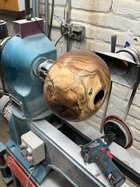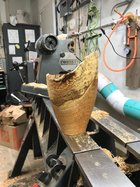Jim McLain
Artist
Screwbean Mesquite with turquoise. Just finished sanding back the ca finish. Want to thank who ever it was that recommended cutting the cord on sanders. Screwbean is a very unusual mesquite in that it really moves during the drying process and is more porous than other mesquites.



































